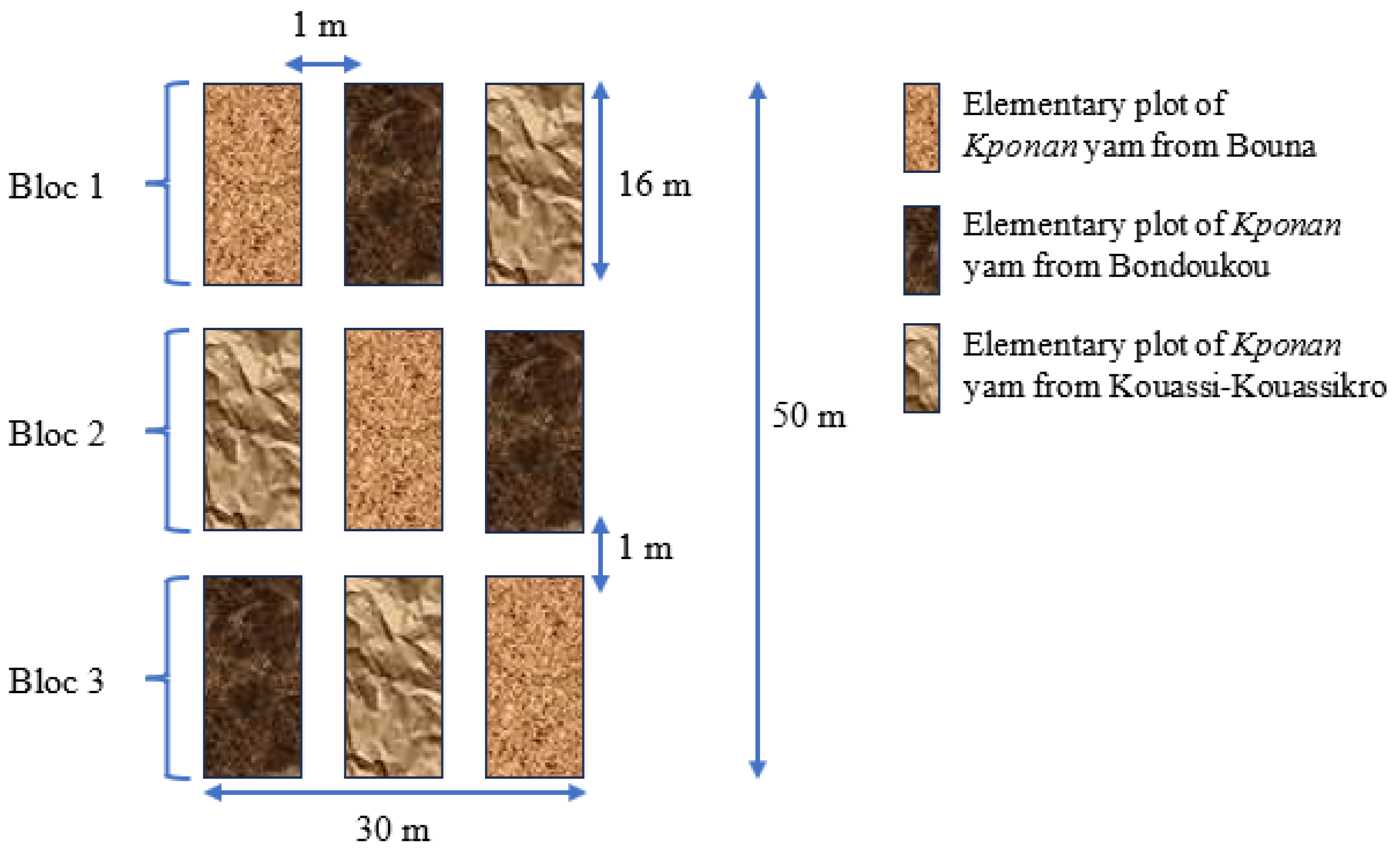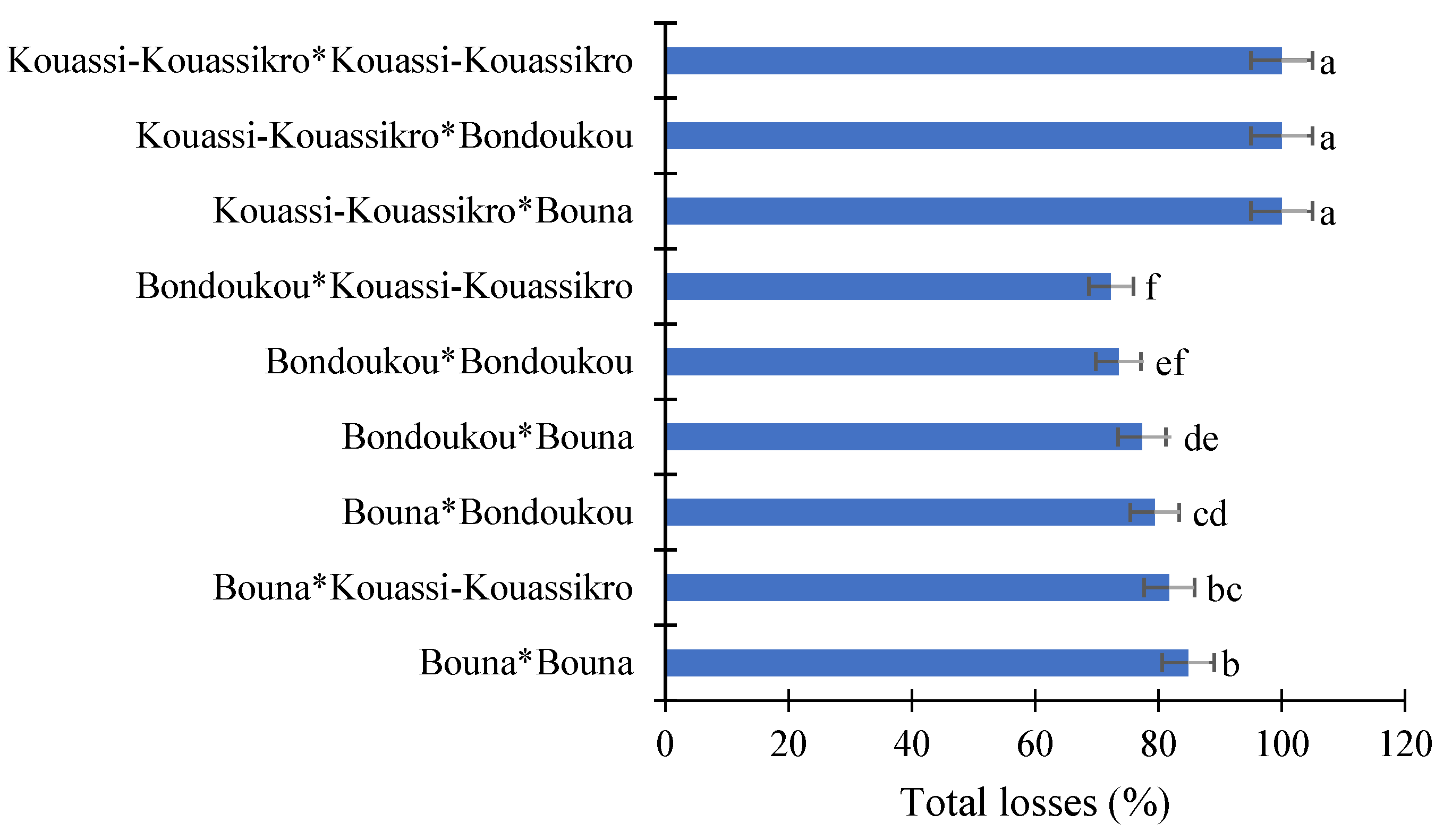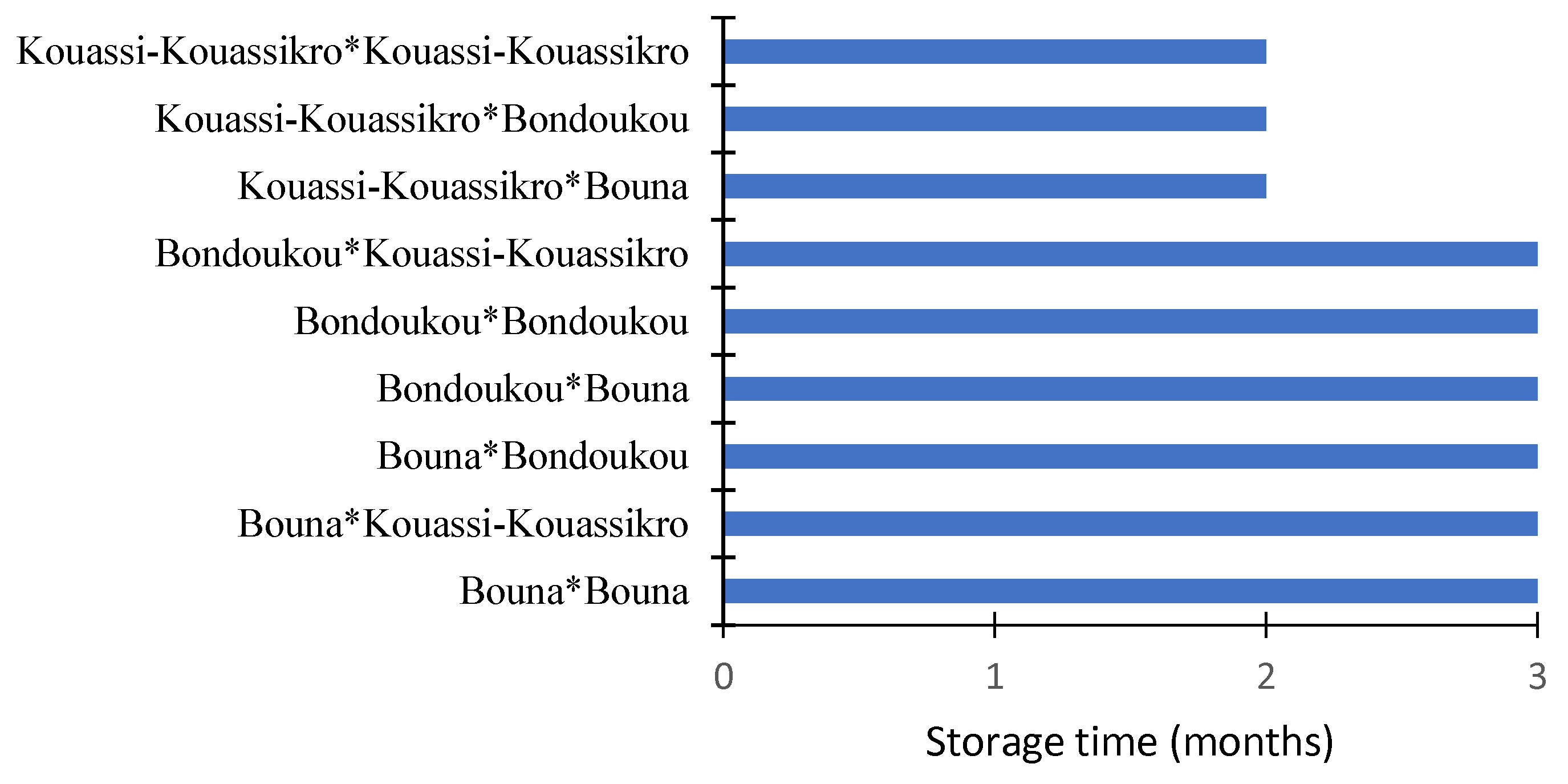Influence of Cultivation Practices on Yield and Spoilage of Kponan Yam (Dioscorea cayenensis-rotundata) During Storage †
Abstract
1. Introduction
2. Material and Methods
2.1. Material
2.2. Methods
2.2.1. Implementation of the Experimental Design
2.2.2. Tuber Weight
2.2.3. Storage Conditions for Kponan Yams
2.2.4. Determination of Tuber Damage During Storage
2.2.5. Data Analysis
3. Results
3.1. Distribution of Tuber Weight at Harvest
3.2. Damage Recorded During Field Storage
3.3. Damages Recorded During Storage in the Warehouse
4. Discussion
5. Conclusions
Author Contributions
Funding
Institutional Review Board Statement
Informed Consent Statement
Data Availability Statement
Acknowledgments
Conflicts of Interest
References
- Wang, S.; Gao, W.; Liu, H.; Chen, H.; Yu, J.; Xiao, P. Studies on the physicochemical, morphological, thermal and crystalline properties of starches separated from different Dioscorea opposita cultivars. Food Chem. 2006, 99, 38–44. [Google Scholar] [CrossRef]
- Onyeka, T.; Petro, D.; Ano, G.; Etienne, S.; Rubens, S. Resistance in water yam (Dioscorea alata) cultivar in the French West Indies to anthracnose disease based on tissue culture-derived whole-plant assay. Plant Pathol. 2006, 55, 671–678. [Google Scholar] [CrossRef]
- FAOSTAT. 2022. Available online: https://www.fao.org/faostat/en/#data/QCL (accessed on 5 August 2022).
- Asiedu, R.; Sartie, A. Crops that feed the World 1. Yams Yams for income and food security. Food Sec. 2010, 2, 305–315. [Google Scholar] [CrossRef]
- Darkwa, K.; Olasanmi, B.; Asiedu, R.; Asfaw, A. Review of empirical and emerging breeding methods and tools for yam (Dioscorea spp.) improvement: Status and prospects. Plant Breed. 2020, 139, 474–497. [Google Scholar] [CrossRef]
- Mignouna, D.B.; Akinola, A.A.; Abdoulaye, T.; Alene, A.D.; Manyong, V.; Maroya, N.G.; Aighewi, B.A.; Kumar, L.P.; Balogun, M.; Lopez-Montes, A.; et al. Potential returns to yam research investment in sub-Saharan Africa and beyond. Outlook Agric. 2020, 49, 215–224. [Google Scholar] [CrossRef]
- Akinola, A.A.; Ezeorah, S.N.; Nwoko, E.P. Modelling the rehydration characteristics of White Yam. West Indian J. Eng. 2019, 41, 70–76. [Google Scholar]
- Dappah, K.D.; Kouassi, K.N.; Kouadio, Y.H.; N’Dri, Y.D.; Amani, N.G. Glycemic index and glycemic load of yam (Dioscorea cayenensis-rotundata) porridge with Talinum triangulare sauce tested in human subjects. GSC Biol. Pharm. Sci. 2023, 22, 056–063. [Google Scholar] [CrossRef]
- Maliki, R.; Sinsin, B.; Floquet, A. Evaluating yam-based cropping systems using herbaceous legumes in the savannah transitional agro-ecological zone of Benin. J. Sustain. Agric. 2012, 36, 440–460. [Google Scholar] [CrossRef]
- Adifon, F.H.; Yabi, I.; Vissoh, P.; Balogoun, I.; Dossou, J.; Saïdou, A. Écologie, systèmes de culture et utilisations alimentaires des ignames en Afrique tropicale: Synthèse bibliographique. Cah. Agric. 2019, 28, 22. [Google Scholar] [CrossRef]
- Kouakou, K.P.; Anoh, K. Geotraçabilité de l’igname Kponan de Bondoukou. Rev. Trimest. Des Sci. Soc. RSS-PASRES 2019, 23, 2311–5890. [Google Scholar]
- INS. Recensement Général de la Population et de l’Habitat (RGPH): Technical Report; Ministère de l’Economie, du Plan et du Développement Résultats Globaux: Abidjan, Côte d’Ivoire, 2021; p. 37. [Google Scholar]
- Girardin, O.; Nindjin, C. Amélioration de la conservation de l’igname en milieu villageois. Sempervira 2015, 5, 1025–8167. [Google Scholar] [CrossRef]
- Maroya, N.; Balogun, M.; Aighewi, B.; Mignouna, D.B.; Kumar, P.L.; Asiedu, R. Transforming Yam Seed Systems in West Africa. In Root, Tuber and Banana Food System Innovations; Springer International Publishing: Cham, Switzerland, 2022; pp. 421–451. [Google Scholar] [CrossRef]
- Kouamé, J.; Gnangui, S.N.; Koné, F.M.T.; Kouamé, L.P. Use of Kinetic and Thermodynamic Parameters for the Prevention of Enzymatic Browning of Edible Yam Dioscorea cayenensis-rotundata cv. “Zrèzrou” Department of Food Science and Technology, University Nangui Abrogoua. Int. J. Curr. Microbiol. App.Sci. 2017, 6, 4176–4187. [Google Scholar] [CrossRef]
- Corneille, A.; Agbidinoukoun, A.; Agbangla, C.; Adjanohoun, A.; Kumulungui, B.; Ondo, P.; Nzang, R.; Souza, P. Capacité morphogénétique in Vitro de quelques accessions d’ignames du Complexe Dioscorea cayenensis/D. rotundata cultivées au Bénin et évaluation de la quantité d’ADN Matériel régénéré. Rev. Ivoir. Sci. Technol. 2012, 20, 68–86. [Google Scholar]
- Kouadio, Y.H.; Kouassi, K.N.; Kouassi, K.B.; Konan, G.A.J.; Kouakou, K.A.; Dappah, K.D.; N’dri, Y.D.; Amani, N.G. Effect of warehouse storage on the alteration, cooking and organoleptic characteristics of Kponan yam (Dioscorea cayenensis-rotundata) of Côte d’Ivoire. Heliyon 2024, 10, e40014. [Google Scholar] [CrossRef]
- Kouadio, Y.H.; Kouassi, K.N.; Konan, Y.; N’Dri, Y.D.; Amani, N.G. Practices and damages encountered by wholesale traders during ‘Kponan’ yams (Dioscorea cayenensis-rotundata) storage in Abidjan, Côte d’Ivoire. Int. J. Biol. Chem. Sci. 2022, 16, 1570–1579. [Google Scholar] [CrossRef]
- Bagal, M.; Vittori, M. Les Indications Géographiques en Côte d’Ivoire, Produits Potentiels et Cadre Juridique Pertinent. 2010. Available online: https://www.origin-gi.com/wp-content/uploads/2010/11/papier-pays_cte-divoire_origin1.pdf (accessed on 16 May 2025).
- Kouakou, K.P.; Kouassi, C.A.; Anoh, K.P. Le marche de gros de l’igname Kponan à Abidjan (Côte D’ivoire). Eur. Sci. J. 2019, 15, 218–238. [Google Scholar] [CrossRef]
- Kouadio, Y.H.; Kouassi, K.N.; Nimaga, D.; N’Dri, Y.D.; Amani, N.G. Impacts of Field Harvesting and Conservation Practices on the Physical Quality of Yam “Kponan” (Dioscorea cayenensis-rotundata) of Côte D’Ivoire. Open J. Appl. Sci. 2022, 12, 1979–1994. [Google Scholar] [CrossRef]
- Kouassi, K.N.; Kouadio, Y.H.; Kouassi, K.B.; N’Dri, Y.D.; Amani, N.G. Impacts of storage practices on the physical, culinary and sensory quality of Kponan yam (Dioscorea cayenensis-rotundata) from Côte d’Ivoire during storage. J. Sci. Food Agric. 2023. [Google Scholar] [CrossRef] [PubMed]
- Osunde, Z.D.; Orhevba, B.A. Effects of storage conditions and storage period on nutritional and other qualities of stored yam (Dioscorea spp.) tubers. Afr. J. Food Agric. Nutr. Dev. 2009, 9, 1684–5374. [Google Scholar] [CrossRef]
- Ola, F.A.; Akande, F.B.; Fadeyibi, A.; Busari, R.A. Physical parameters of some varieties of yam tubers relevant in the design of mechanical yam harvester. Tech. Sci. J. Community Dev. Afr. 2021, 2, 39–45. [Google Scholar]
- FIRCA. Répertoire de Technologies de Conservation et de Transformation de l’igname et de la Banane Plantain; Fonds Interprofessionnel pour la Recherche et le Conseil Agricoles. Groupe le Prestige: Abidjan, Côte d’Ivoire, 2010; 155p. [Google Scholar]
- Ngue, B.T.; Mbairanodji, A.; Njualem, D. Guide des techniques de production et de conservation d’igname (Dioscorea spp.). 2007. Available online: http://www.mangalani-consult.org/fichiers/ressources/FA08_Igname.pdf (accessed on 16 May 2025).
- Aidoo, A.K.; Arthur, S.; Bolfrey-arku, G.; Osei, K.; Lamptey, J.N.L.; Mochiah, M.B.; Ohene-mensah, G.; Frimpong, F.; Appiah-kubz, I.; Owusu danquah, E. Storage rot of seed yam resulting from speargrass injuries. Afr. Crop Sci. J. 2020, 28, 203–211. [Google Scholar] [CrossRef]
- Assiri, K.P.; Koutoua, S.; Assi, S.T. Champignons responsables de pourritures de l’igname Dioscorea cayenensis-rotundata variété “Kponan” en post récolte. J. Appl. Biosci. 2017, 111, 10957–10968. [Google Scholar] [CrossRef]
- Bosrotsi, C.K.; Addo, A.; Dzisi, K.A.; Agodzo, S.K. Development of a Yam Harvester using Finite Element Method. Int. J. Mod. Stud. Mech. Eng. 2017, 3, 35–44. [Google Scholar]





| Rot (%) | Weight Loss | Crack (%) | Total Losses | |
|---|---|---|---|---|
| Bouna*Open air | 60.00 a | 25.71 e | 14.29 a | 100.00 a |
| Bondoukou*Open air | 57.14 ab | 28.57 d | 14.29 a | 100.00 a |
| Kouassi-Kouassikro*Open air | 57.14 ab | 31.43 c | 11.43 b | 100.00 a |
| Bouna*Straw hut | 48.58 c | 42.86 a | 8.57 c | 100.00 a |
| Bondoukou*Straw hut | 57.14 ab | 31.43 c | 11.43 b | 100.00 a |
| Kouassi-Kouassikro*Straw hut | 54.29 b | 34.29 b | 11.43 b | 100.00 a |
| Bouna*Pit | 22.86 e | 8.57 g | 8.58 c | 40.00 d |
| Bondoukou*Pit | 25.72 e | 11.42 f | 5.71 d | 42.85 c |
| Kouassi-Kouassikro*Pit | 31.43 d | 11.43 f | 5.71 d | 48.57 b |
Disclaimer/Publisher’s Note: The statements, opinions and data contained in all publications are solely those of the individual author(s) and contributor(s) and not of MDPI and/or the editor(s). MDPI and/or the editor(s) disclaim responsibility for any injury to people or property resulting from any ideas, methods, instructions or products referred to in the content. |
© 2025 by the authors. Licensee MDPI, Basel, Switzerland. This article is an open access article distributed under the terms and conditions of the Creative Commons Attribution (CC BY) license (https://creativecommons.org/licenses/by/4.0/).
Share and Cite
Kouadio, Y.H.; Kouassi, K.N.; Konan, G.A.J.; Kouakou, K.A.; Assanvo, B.J.; N’dri, Y.D. Influence of Cultivation Practices on Yield and Spoilage of Kponan Yam (Dioscorea cayenensis-rotundata) During Storage. Proceedings 2025, 118, 6. https://doi.org/10.3390/proceedings2025118006
Kouadio YH, Kouassi KN, Konan GAJ, Kouakou KA, Assanvo BJ, N’dri YD. Influence of Cultivation Practices on Yield and Spoilage of Kponan Yam (Dioscorea cayenensis-rotundata) During Storage. Proceedings. 2025; 118(1):6. https://doi.org/10.3390/proceedings2025118006
Chicago/Turabian StyleKouadio, Yapo Hypolithe, Kouakou Nestor Kouassi, Gbè Aya Jacqueline Konan, Kouame Aristide Kouakou, Bomo Justine Assanvo, and Yao Denis N’dri. 2025. "Influence of Cultivation Practices on Yield and Spoilage of Kponan Yam (Dioscorea cayenensis-rotundata) During Storage" Proceedings 118, no. 1: 6. https://doi.org/10.3390/proceedings2025118006
APA StyleKouadio, Y. H., Kouassi, K. N., Konan, G. A. J., Kouakou, K. A., Assanvo, B. J., & N’dri, Y. D. (2025). Influence of Cultivation Practices on Yield and Spoilage of Kponan Yam (Dioscorea cayenensis-rotundata) During Storage. Proceedings, 118(1), 6. https://doi.org/10.3390/proceedings2025118006






